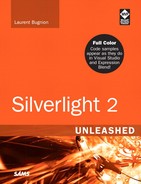Introduction
With the release of Windows Presentation Foundation (a new graphical user interface framework for Windows desktop applications) in 2006 and of Silverlight in 2008, client application development took a turn for the best. Microsoft boldly decided to abandon some concepts and technologies that had been used since the first release of Windows and to do something new and better. While it sometimes seems difficult to keep up with the pace of change imposed on software developers, this one is really worth it. Microsoft’s bet on Silverlight and WPF is huge, and it cannot fail. These technologies represent the future of client application development.
Because it runs on multiple platforms in a web browser plug-in that will soon be available on most of the rich clients accessing the Internet, because it can be deployed as easily as any web content and be served from any web server without additional infrastructure, and because of the rich graphic interfaces it allows to be built and the amazingly easy connectivity to remote services that it offers, Silverlight will be a major player in the world of rich interactive applications (RIA). Silverlight is also a gateway to Windows Presentation Foundation, the client application technology that represents the future of Microsoft Windows programming for desktop computers.
In a World Wide Web where Adobe Flash currently has a leading edge, Silverlight represents much more than just an alternative: It is the .NET way! Every .NET programmer will feel at home with Silverlight, because the libraries, the programming languages (C#, VB.NET, Ruby, Python), and the development environment (Visual Studio, Expression Studio) are the same. In addition, new concepts developed and refined in Windows Presentation Foundation are made available to Silverlight programmers, such as data binding, separation of behavior and looks, lookless controls that can be styled and templated at will in powerful design tools such as Expression Blend, a rich animation system, media integration, and so on. XAML, the new XML-based Application Markup Language developed by Microsoft, can be leveraged as a bridge between developers and designers to enable new workflows.
This book is not and was never intended to be a complete reference of the Silverlight platform. Honestly, I am not even sure that you need a book for this: The Internet is at your disposal and has a better, more complete, and more actual reference base than any book can ever offer. No, this book is here to help you discover why programming is fun and why Silverlight is even more fun, and to contaminate you with the Silverlight virus. Complex concepts are explained in simple terms, with many hands-on demos and figures so that beginners as well as advanced developers quickly will feel at home.
About Code in This Book
We tried to keep formatting as consistent as possible throughout the book and to make the code look like it does in Visual Studio. The code is color coded to help you work faster and recognize key concepts in XAML, C#, JavaScript, and HTML in Studio and in Expression Blend.
The source code lines are only numbered where it is relevant, for example, when the text makes explicit reference to a line number.
The whole source code for this book is available online at www.galasoft.ch/SL2U/Code. For C# code, a translation in VB.NET is also available, courtesy of this book’s technical editor, J. Boyd Nolan.
One Year Older
I started working on this book in September 2007, and I am now exactly one year older. Professionally speaking, it has been the most interesting year of my life. Since I started working as a developer in 1996, I have worked with many client technologies and programming languages, including C, VB, Java, HTML, CSS, JavaScript, ASP.NET, Windows Forms and finally Windows Presentation Foundation and Silverlight. In all these years, I have never been as excited about a new programming platform. Writing a book is hard, and it’s a lot of work. But it was also fun and so interesting that I always felt right doing it. If I had to do it again, I would sign without hesitation. And now that it’s going to be published, I can’t wait to see what you, the reader, will create in Silverlight. Software has much to do with art, and Silverlight is the richest palette you can imagine. So grab the book and your computer, start coding and designing, and show the world what you can do. I will be waiting.
Happy coding!
Laurent
